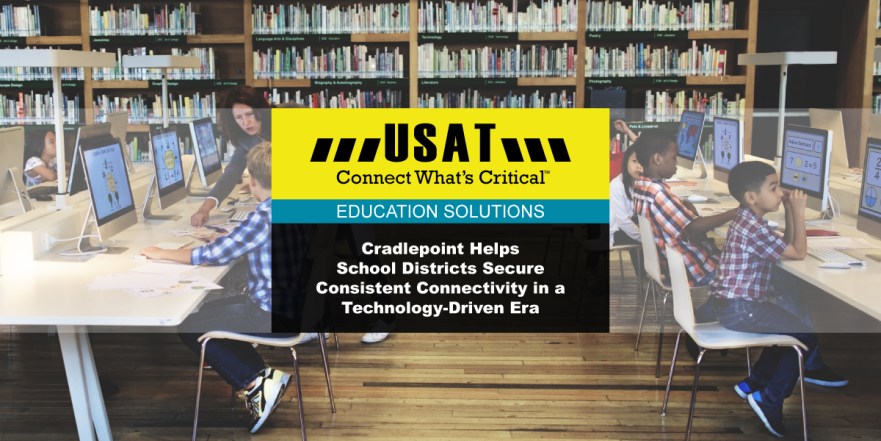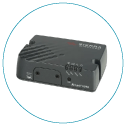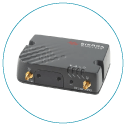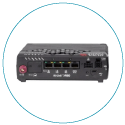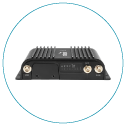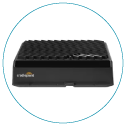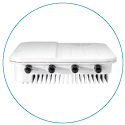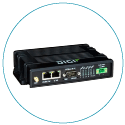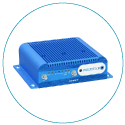School Districts Must Ensure Reliable Connectivity In An Era Extremely Reliant On Technology
The days of blackboards, three-hole punches, and freshly sharpened No. 2 pencils are long gone. In today's K-12 educational landscape, students and teachers rely heavily on laptops, tablets, cloud applications, data-driven instruction, and uninterrupted Internet connectivity.
As a result of significant shifts like online testing for Common Core standards and the rapid proliferation of cloud-based tools, many school districts are actively searching for networking solutions that can adapt to their evolving requirements without adding complexity to network management or introducing new security risks. K-12 IT teams find themselves tasked with embracing new technologies while simultaneously addressing various challenges related to bandwidth, cybersecurity, reliability, flexibility, scalability, and cost efficiency.
LTE-based broadband and WiFi have become indispensable elements of K-12 network infrastructures in response to these pressing needs. Wireless WAN connectivity has transitioned from a mere luxury for school districts to an absolute necessity for enhancing and customizing the learning experience — whether within school premises, on school buses, or through IoT devices.
The Shifting Landscape of K-12 Technology
K-12 education remains a cornerstone of our society, but how it operates has undergone significant transformations. Due to the ever-expanding array of technologies, trends, and innovations, schools and districts are now tasked with delivering Internet connectivity within and beyond their campuses.

Common Core Integration
In states that have embraced the Common Core State Standards, online testing has become a routine and crucial aspect of school life. While online assessments offer distinct advantages, they hinge on one essential factor: a seamless Internet connection with plenty of bandwidth.
The Rise of Cloud-Based Applications
Rather than constantly replacing traditional textbooks and software, educational institutions are turning to cloud-based applications and Massively Open Online Courses (MOOCs) to refine students' skills in coding, mathematics, foreign languages, and more.
Similarly, educators now have the capability to upload grades, assignments, attendance records, messages, and lecture videos to cloud-based platforms accessible to students from anywhere.
Educational resources are perpetually within reach as long as network connectivity endures.
1:1 and Bring-Your-Own-Device (BYOD) Initiatives
Educational institutions can save costs by replacing traditional computer labs with a one-to-one computing approach, commonly called 1:1. This strategy ensures each student possesses a laptop, tablet, or a comparable mobile device. In cases where schools face budget constraints that prevent the provision of mobile devices for every student, they often incorporate a "Bring-Your-Own-Device" (BYOD) component into the policy. Additionally, schools endeavor to supply as many district-owned devices as feasible within these initiatives.
1:1 policies and BYOD initiatives serve as catalysts for leveling the educational playing field, ensuring that every student can harness the power of technology and cloud-based applications within the classroom, during transportation, and even at home.
However, for network administrators, the multitude of devices accessing the network introduces heightened complexity in terms of management and security.
AR/VR Revolution
Augmented Reality (AR) and Virtual Reality (VR) tools allow students to explore realms that would otherwise be beyond their reach. These technologies enable students to delve into historical events, visit museums, explore national parks and monuments, travel to distant countries, and immerse themselves in exotic environments — all from the confines of their classroom. These experiences are made possible using various devices, including laptops, tablets, apps, and AR/VR headsets, placing a wealth of knowledge and experiences at students' fingertips.
Personalized, Data-Driven Education
Educators are harnessing online platforms and mobile devices to conduct assessments that pave the way for data-driven, tailored curricula based on each student's unique interests, capabilities, progress, and mastery of content.
This approach empowers teachers to swiftly identify and address academic challenges students encounter in specific subjects. Through quizzes and assessments, educators can pinpoint areas requiring further review or different teaching strategies well before test days.
Enhancing Child Safety Measures
In today's climate of heightened concern for child safety, school security has evolved far beyond the traditional stationed guard at the main entrance. School districts are now implementing Internet of Things (IoT) security measures, including Radio-Frequency Identification (RFID) cards that enable students to scan in and out of buses and buildings. This technology facilitates easy tracking of attendance and children's whereabouts, providing peace of mind for parents and educational institutions.
Additionally, internet-connected surveillance cameras strategically placed on school campuses and buses transmit real-time footage to central headquarters. The mere presence of these systems often acts as a deterrent to potentially dangerous or illegal activities.

Addressing K-12 Networking Challenges
Bandwidth Allocation
Provisioning and effectively managing bandwidth pose significant challenges for IT teams in K-12 schools. The network must seamlessly accommodate students' and educators' constant use of devices for activities such as streaming audio and video content and accessing cloud-based applications throughout the campus.
During peak data usage periods, IT administrators must possess the agility to adapt to fluctuating bandwidth demands on the fly. However, these adjustments must be made without incurring excessive fees that could impose an undue financial burden on budget-conscious school districts. For instance, when students, teachers, and administrators log onto the network at the beginning of the school day, the team should be able to scale up bandwidth and adjust it as the day progresses.
To address the challenges related to bandwidth management and network adaptability in K-12 schools, consider the following solutions:
Upgrade Connectivity Devices
Augment or replace your existing connectivity devices with a cloud-managed LTE-enabled solution. Look for enterprise-grade routers that support dual modems, offering benefits such as load balancing, increased bandwidth, and wireless-to-wireless failover capabilities.
Data Plan Selection
Opt for a data plan that allows for data pooling across various locations. This approach provides flexibility during high and low data usage periods, ensuring your network can adapt to changing demands without incurring excessive costs.
LTE-Optimized SD-WAN
Ensure your solution incorporates LTE-optimized Software-Defined Wide Area Network (SD-WAN) technologies. SD-WAN allows for automated, policy-based traffic steering, enabling efficient network traffic management and ensuring that critical applications receive priority.
By implementing these components into your network infrastructure, you can enhance bandwidth management, optimize connectivity, and provide a more reliable and adaptable network for K-12 schools, ultimately improving the overall educational experience.
Cybersecurity Challenges in Education
School district IT departments face the formidable task of ensuring compliance with laws safeguarding students from inappropriate and dangerous online content. The Children's Internet Protection Act (CIPA) is paramount for student safety. Still, it becomes increasingly complex to uphold as students and their devices become more mobile. Non-compliance with CIPA jeopardizes student safety and exposes the district to legal and financial liabilities.
Additionally, the personal data of minors is a lucrative target for hackers, and children's Social Security numbers are often less protected than those of adults. Like corporations and government entities, schools are entrusted with safeguarding the data of their employees and the individuals they serve. Still, they often must do so with fewer resources.
To address these cybersecurity challenges effectively, consider the following solutions:
Comprehensive Network Solution
Opt for a network solution incorporating a built-in firewall, easy-to-use VPN capabilities, robust network segmentation, multiple SSIDs (Service Set Identifiers), and content filtering.
Remote Management
Ensure the network solution allows remote management, enabling IT administrators to handle updates and integrate additional security measures seamlessly and efficiently.
Cloud Integration
Select a solution that offers compatibility with industry-leading security platforms through the cloud. This integration enhances the overall security posture of the school district's network.
By implementing this comprehensive cybersecurity solution, school districts can better protect students from harmful online content, maintain compliance with regulations like CIPA, and fortify their defenses against data breaches and cyberattacks, even with limited resources.
Reliability
Internet downtime can disrupt crucial operations in today's educational landscape, bringing everything to a standstill. This includes instructional activities, teacher responsibilities like grading and testing, and communication between the school and parents. Even on school buses, essential tools like student WiFi, location tracking, and streaming security footage lose their value if WAN access is not consistently maintained.
To address these reliability concerns, consider implementing a hybrid WAN solution that supports various connectivity options, including LTE, Ethernet, WiFi-as-WAN, and others, all managed through a single router. Employ a cloud-based management tool that provides real-time alerts and features cloud-based Out-of-Band Management. IT personnel can address downtime and other issues remotely without physical on-site visits.

Flexibility and Cost-Effectiveness
School districts, often constrained by limited budgets, require cost-effective network solutions today and are adaptable for the future. Integrating LTE Internet into existing wired architectures can be complicated, financially burdensome, and prone to human error—especially for districts that lack a cloud management service for centralized monitoring, management, and troubleshooting.
The rapid pace of technological advancements and school expansion further complicates matters, making it challenging for IT managers to keep up with limited resources. IT administrators must be able to efficiently manage and troubleshoot mobile deployments remotely efficiently, minimizing the impact on staff and budgets.
To do this, districts may consider deploying an all-in-one network solution that seamlessly integrates wired and wireless links. Look for a solution that offers high-performance LTE connectivity supporting multiple carriers and modems simultaneously. Choose a solution bundled with a cloud management service, allowing instantaneous updates, carrier switching, and troubleshooting from anywhere. This approach ensures flexibility and cost-effectiveness while meeting the evolving needs of school districts.
Enhanced Connectivity on School Buses
Imagine the advantages of having an LTE-based mobile router installed on school buses, transforming the travel experience and enhancing safety:
Homework on the Go
Students traveling to and from home or attending out-of-town events can now access WiFi on the school bus, enabling them to complete homework assignments during their commute.
Instant Safety Alerts
With LTE connectivity, bus drivers can promptly notify school administrators or stream live surveillance footage back to district headquarters in case of a dangerous incident.
Efficient Data Management
Additionally, the district can automatically offload less-critical surveillance footage via WiFi the next time the vehicle parks at headquarters, optimizing data storage and bandwidth usage.
Additionally, some fleet managers require in-vehicle connectivity to facilitate AVL (Automatic Vehicle Location) solutions and harness valuable insights from telematics data to enhance cost-efficiency. GPS tracking ensures continuous monitoring of bus locations. Schools sometimes offer phone apps allowing parents and students to track the bus's location.
Main School Building Network Solutions
In a small school building, an all-in-one router offers multi-WAN connectivity and seamless failover through a single device. However, on a much larger campus, the school's IT team may require a branch continuity solution that converts LTE into an Ethernet connection, ensuring a 99.99% uptime.
Digital signage has become increasingly prevalent in K-12 settings, extending beyond the readerboard in front of the main building. School staff can remotely update and manage digital signage across the entire campus without physical intervention. The deployment of an LTE-enabled IoT router simplifies the process, allowing digital signage to be placed anywhere on campus without the hassle of extending fiber or Ethernet connections.
Including Cloud-based Out-of-Band Management capabilities empowers IT teams to use 4G LTE for remote access to a primary router or any LAN-connected devices. This remote troubleshooting capability saves schools valuable time and resources by eliminating the need to dispatch IT specialists to sites experiencing outages or hardware failures.
Temporary Classrooms and Portables
Temporary classrooms serve various purposes within school districts. They are essential for accommodating standardized testing areas in large spaces like gymnasiums and addressing overcrowding with portable buildings. While these temporary spaces are typically connected through existing infrastructure, there are situations where establishing a connection quickly is essential. In such cases, utilizing an LTE or WiFi-as-WAN connection through a router expedites the operational readiness of portable classrooms.
Video Surveillance
Ensuring the safety of students is a top priority for many school districts. Some districts deploy cloud-managed IoT solutions to maintain continuous connections to security cameras. Additionally, certain districts have their own law enforcement vehicles equipped with mobile routers to facilitate data and video connectivity between officers and the district, further enhancing security measures.
Special Events
Schools host many special events throughout the year, including sports competitions, plays, musical performances, and more. Accepting credit card payments has become essential in the modern era. Therefore, schools must have the capability to provide secure and reliable network access for Point-of-Sale (POS) systems at a moment's notice during these events, ensuring a smooth and efficient experience for attendees.
K-12 Solutions for Branch, Mobile, and IoT Deployments: Cradlepoint's Comprehensive Approach
Cradlepoint offers all-inclusive NetCloud Solution Packages designed to address the unique needs of K-12 school districts when it comes to branch, mobile, and IoT network deployments. These packages blend tailored NetCloud services with purpose-built hardware and an extensive 24x7 support plan, providing a holistic solution for educational institutions.
Essentials Packages for Rapid Deployment
Each Essentials package is carefully crafted to deliver essential functionality for swift deployment and immediate value. These packages offer a solid foundation for schools to get started with their network solutions.
Advanced Upgrade Packages for Enhanced Networks
Advanced upgrade packages empower customers to elevate their networks anytime and anywhere. These packages introduce advanced management tools and edge routing capabilities, ensuring schools can adapt and grow their networks as needed.
Enhanced Security Functionality
The advanced branch and mobile solution packages include enhanced security features, such as application-aware firewall and CP Secure Web Filter. This web filtering solution is fortified by industry-leading Webroot BrightCloud® Threat Intelligence and seamlessly integrated into Cradlepoint NetCloud. CP Secure Web Filter allows network administrators to proactively safeguard users from web-based threats and maintain IT compliance at the distributed WAN edge.
Integration with Third-Party Tools
Schools leveraging branch and mobile solution packages can effortlessly incorporate third-party tools into their network infrastructure. These tools may include analytics-rich web content filtering, like Zscaler Internet Security, and intrusion prevention/detection systems (IPS/IDS), such as CP Secure Threat Management, powered by Trend Micro's top-tier Deep Packet Inspection Engine.
Along with USAT, Cradlepoint's comprehensive approach ensures that K-12 school districts can access tailored, secure, and scalable network solutions that meet their specific requirements, from rapid deployment to advanced security enhancements and seamless integration with third-party tools. This holistic approach ultimately enables educational institutions to provide reliable, secure, high-performing student and staff network services.
Success Stories
LA Unified School District
The Los Angeles Unified School District (LAUSD) faced the significant challenge of ensuring uninterrupted Internet access, particularly for the Smarter Balanced Assessment Test, which was based on the Common Core and demanded constant connectivity across its administrative offices and school sites. LAUSD sought a reliable solution to maintain seamless online testing for its students.
The district turned to Cradlepoint, a purpose-built branch network solutions provider with multi-WAN functionality. These solutions were specifically designed to address the complex connectivity needs of organizations like LAUSD.
LAUSD implemented Cradlepoint's branch connectivity and branch continuity solutions, which included Out-of-Band Management functionality. These solutions allowed LAUSD to support wired and wireless links through a single device, providing flexibility and redundancy in their network architecture.
To streamline network management and monitoring, LAUSD leveraged Cradlepoint's NetCloud Service.
This cloud-based platform enabled the district's IT team to centrally oversee and manage connectivity across more than 700 square miles of educational facilities. The result was a significant reduction in the need for physical service calls and man-hours spent troubleshooting network issues.
Fresno Unified School District
In the Fresno Unified School District (FUSD), students who commute by school bus typically spend an average of 30 minutes on their journeys. Recognizing the opportunity to optimize this time, the district implemented a solution to transform the bus ride into a productive learning environment.
FUSD partnered with Cradlepoint to deploy purpose-built in-vehicle network solutions, equipping school buses with on-board WiFi. This initiative empowered students to complete schoolwork, engage in educational activities, and stay connected while traveling on the bus and during school events.
To ensure uninterrupted connectivity, the district's IT team could effortlessly switch between multiple carriers as needed, all within a single service. This flexibility allowed them to maintain always-on Internet access regardless of the circumstances.
Cradlepoint's NetCloud Service provided centralized oversight, management, and troubleshooting for all devices within the fleet network. Additionally, content filtering was extended to protect students from accessing inappropriate websites, ensuring a safe online environment.
Fresno Unified School District's collaboration with Cradlepoint transformed school bus rides into valuable learning opportunities for students, making the most of their commute time. By providing on-board WiFi and ensuring robust connectivity, the district successfully enhanced the educational experience and enabled the safety of students in the digital realm.
About USAT
USAT specializes in designing and deploying fixed and mobile wireless data connectivity solutions for schools and learning facilities of all sizes — complete with implementation, training, proof of concept (POC), system auditing, and on-site RF surveying services with optional engineering maintenance contracts
Our team not only helps you select, provision, and activate devices, we make sure they work in practical applications and real-life situations.
As an Elite 5G Certified Resale Partner of Cradlepoint, USAT is uniquely equipped to provide secure cellular communications solutions for educational institutions across the USA. With our extensive catalog of world-class routers, gateways, and software designed for remote monitoring and management in even the harshest environments — you can count on us to get and keep you connected.
Better connectivity translates to reduced downtime and an overall increase in your district’s operating ROI. Contact the experts at USAT to learn how our wireless networking solutions can help meet your organization's exacting needs.
Share this Post

